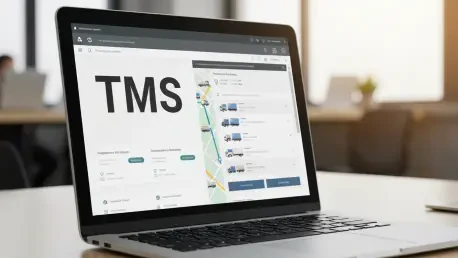In an era where global supply chains are more intricate than ever, the logistics industry grapples with the challenge of meeting skyrocketing consumer expectations while curbing operational costs. Transportation Management Software (TMS) has emerged as a pivotal solution, revolutionizing how businesses orchestrate transportation operations amidst the e-commerce boom and complex international trade networks. Valued at a staggering USD 9.5 billion in the current market landscape, with projections estimating growth to USD 20.7 billion by 2033 at a compound annual growth rate (CAGR) of 9.7%, TMS stands as a linchpin for efficiency and innovation. This analysis dives deep into the market dynamics, exploring key trends, technological advancements, and regional disparities that define the TMS landscape. By dissecting data and forecasts, the aim is to illuminate how this software is not just adapting but fundamentally transforming logistics for a competitive global economy.
Market Overview: The Backbone of Modern Logistics
The TMS market is experiencing robust expansion, driven by an urgent need for streamlined logistics in a digitally connected world. As supply chains stretch across continents, businesses face mounting pressure to optimize routes, manage carriers, and ensure real-time visibility into shipments. TMS addresses these demands by integrating advanced tools that automate critical processes, ultimately reducing costs and enhancing delivery timelines. The projected growth from USD 9.5 billion today to USD 20.7 billion by 2033 underscores the software’s indispensable role in modern trade, with a steady CAGR of 9.7% reflecting sustained industry adoption.
Beyond mere numbers, the significance of TMS lies in its capacity to tackle longstanding inefficiencies that have plagued logistics for decades. Manual processes, once the norm, often led to errors in documentation and suboptimal routing, inflating expenses and delaying shipments. The shift toward digital solutions, particularly over the last few years, has positioned TMS as a cornerstone for companies aiming to stay competitive, especially in high-stakes sectors like retail and manufacturing. This market momentum is fueled by a convergence of technological innovation and evolving consumer demands, setting the stage for a deeper exploration of specific trends.
Key Trends Shaping the TMS Landscape
Digital Transformation and Automation Surge
A dominant force propelling the TMS market is the wave of digital transformation sweeping through logistics. Automation, powered by artificial intelligence (AI) and machine learning (ML), is redefining operational workflows by minimizing human error in tasks like load planning and freight auditing. Businesses leveraging TMS report substantial cost savings—some achieving up to 30% reductions in transportation expenses through optimized routing algorithms. This trend is particularly evident in large-scale operations where automated systems ensure seamless coordination across vast delivery networks.
Moreover, the integration of real-time data analytics into TMS platforms enhances decision-making capabilities. Companies can now respond swiftly to disruptions, such as weather delays or traffic bottlenecks, by dynamically adjusting routes and schedules. While the upfront investment in such systems can be significant, the long-term benefits of improved efficiency and compliance with regulatory standards are driving widespread adoption across industries, from logistics providers to global retailers.
E-commerce Growth Fueling Last-Mile Innovations
The explosive rise of e-commerce continues to reshape the TMS market, with last-mile delivery optimization emerging as a critical focus area. As online shopping becomes ubiquitous, retailers face intense pressure to meet consumer expectations for rapid, often same-day, delivery. TMS solutions enable real-time route adjustments and automated carrier assignments, ensuring efficiency even during peak demand periods like holiday seasons. This capability is vital for maintaining customer satisfaction in a highly competitive digital marketplace.
Integration with warehouse management systems further amplifies TMS effectiveness, creating a cohesive framework for managing inventory and dispatch. However, challenges persist, such as data overload and the need for robust infrastructure to support these advanced tools. Despite these hurdles, the ability of TMS to streamline last-mile logistics positions it as an essential asset for e-commerce giants and smaller retailers alike, adapting to the relentless pace of online consumer behavior.
Cloud-Based Solutions Leading Adoption
Cloud-based and Software-as-a-Service (SaaS) models are rapidly gaining traction in the TMS market, offering scalability and flexibility that traditional on-premise systems cannot match. These solutions allow businesses to access real-time shipment data from any location, fostering collaboration with logistics partners and enabling quick responses to market shifts. Small and medium-sized enterprises (SMEs), in particular, benefit from lower initial costs and the ability to scale operations without heavy capital expenditure.
Additionally, cloud platforms provide continuous updates and enhanced security features, addressing concerns about data protection in an increasingly digital landscape. The preference for such deployment models is evident in their growing market share, as they cater to a broad spectrum of users seeking cost-effective ways to modernize logistics. This trend highlights a broader industry move toward agility, ensuring that companies of all sizes can harness TMS without being constrained by legacy infrastructure.
Technological Innovations and Future Projections
AI, IoT, and the Next Frontier
Technological advancements are at the heart of TMS evolution, with AI, machine learning, and the Internet of Things (IoT) leading the charge. AI-driven predictive analytics enable businesses to forecast demand and optimize routes with unprecedented accuracy, while IoT devices embedded in vehicles and cargo provide real-time tracking and condition monitoring. These innovations reduce losses from delays or damage and support proactive maintenance, cutting downtime and operational costs.
Looking ahead, the integration of blockchain for secure freight transactions and autonomous vehicle technologies for driverless fleets promises to further revolutionize the market. Projections indicate that by 2033, TMS platforms will increasingly incorporate features for highly precise analytics, allowing companies to anticipate disruptions before they occur. While these developments signal immense potential, concerns around data security and the scalability of emerging technologies remain critical considerations for future growth.
Sustainability as a Market Driver
Sustainability is emerging as a pivotal driver in the TMS market, aligning with global efforts to reduce environmental impact. Platforms are now equipped with tools to track carbon footprints, optimize routes for fuel efficiency, and select eco-friendly carriers, supporting corporate and regulatory goals for greener supply chains. This focus is particularly pronounced in regions with stringent environmental standards, where TMS adoption is tied to achieving compliance.
Future projections suggest that sustainability features will become standard in TMS offerings, driven by economic factors like fluctuating fuel prices and regulatory shifts toward stricter emissions controls. As companies prioritize eco-conscious practices, the role of TMS in minimizing empty miles and enhancing load optimization will grow, positioning the software as a key enabler of sustainable logistics over the coming years.
Regional Dynamics and Industry Applications
Global Variations in TMS Adoption
The TMS market exhibits significant regional disparities, reflecting diverse economic and infrastructural landscapes. North America holds a leading position, bolstered by advanced logistics networks and early technology adoption, particularly in the United States. Here, the emphasis is on cutting-edge integrations like IoT for real-time cargo monitoring, maintaining a competitive edge in efficiency and innovation.
In contrast, Europe focuses on sustainability, leveraging TMS to reduce carbon emissions through fuel-efficient routing, in line with rigorous environmental regulations. Meanwhile, the Asia-Pacific region stands out as the fastest-growing market, driven by rapid industrialization and e-commerce expansion in countries like China and India. Despite infrastructure challenges, TMS adoption is accelerating, supported by government initiatives for digitalization, illustrating the software’s adaptability to varied global contexts.
Sector-Specific Impacts Across Industries
Across industries, TMS demonstrates remarkable versatility, addressing unique supply chain challenges in sectors ranging from manufacturing to healthcare. Manufacturers rely on TMS to streamline inbound and outbound logistics, ensuring timely delivery of raw materials and finished goods. In healthcare, the software facilitates time-sensitive shipments of medical supplies, where precision and reliability are paramount.
Retail and e-commerce sectors utilize TMS to manage high-volume deliveries and omnichannel inventory, while the food and beverage industry benefits from IoT-enabled temperature controls to preserve product quality. The automotive sector, dealing with global production networks, uses TMS for end-to-end visibility of spare parts logistics. This wide applicability underscores the software’s role as a transformative tool, tailored to meet the distinct demands of each industry while driving overall operational excellence.
Reflecting on Market Insights
Looking back, the analysis of the Transportation Management Software market reveals a transformative journey fueled by digital innovation, e-commerce demands, and a push for sustainability. The remarkable growth trajectory, from a current valuation of USD 9.5 billion to a projected USD 20.7 billion by 2033, highlights the software’s critical role in reshaping logistics. Regional disparities and industry-specific applications further illustrate the adaptability and breadth of TMS impact across global markets. For businesses aiming to capitalize on these insights, the next step involves selecting scalable, cloud-based solutions that align with specific operational needs, ensuring seamless integration with existing systems. Investing in staff training to maximize adoption and partnering with providers offering robust support will be essential to navigate technological advancements. As sustainability becomes a core focus, prioritizing TMS features for eco-friendly practices can position companies as leaders in responsible logistics, preparing them for regulatory shifts and future market expectations.









